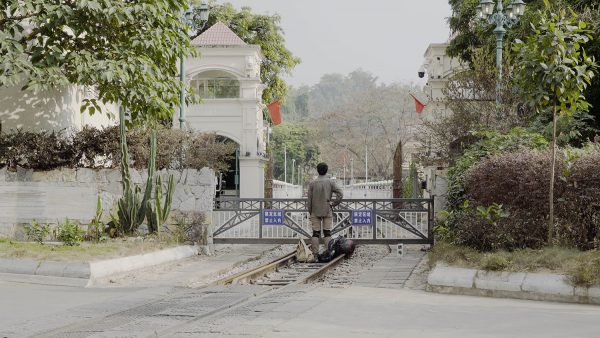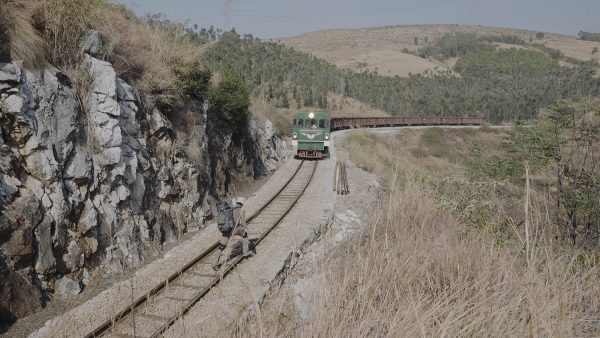程新皓 CHENG Xinhao
程新皓,1985 年出生于雲南。2013 年畢業於北京大學化學與分子工程學院,獲博士學位。現作為藝術家工作生活于雲南昆明。他的作品通常基於長期的田野調查,並均與故鄉雲南相關。通過身體在場的工作方式,程新皓使用錄影、裝置、攝影與文字等媒介,體察不同來源的邏輯、話語、知識與其背後自然、社會、歷史,及鑲嵌於其中的行動者們之間的複調連結。
Cheng Xinhao (b.1985, Yunnan, China) currently lives and works in Kunming, Yunnan. He received his Ph.D in Chemistry from Peking University in 2013. Focusing on his hometown in the Yunnan Province, Xinhao’s works are usually based on long-term field studies. With videos, installations, photographs and the presence of the author’s body, his works investigate the polyphonic relationships between logic, discussions, knowledge, and the part that nature, society, and history plays within them.
在緩慢的觀察與激進的介入之間
我是以昆明為根據地的藝術創作者,這幾年以錄影為主要的創作媒介,進行一些與雲南相關的長期項目。這些項目都有一些人類學的背景,差不多都需要以「年」為單位的時間去完成。譬如我最長的項目是開始於2013年的《陌生地形》(Strange Terrains),它是有關於中越邊境上一群未識別族群的「莽人」,關於他們的知識和空間生產,以及和全球化的關係。這個項目已經持續了七年多,並且還將長期進行下去。我的工作方式自然需要貼合於這樣的長期項目的特點,不斷往返於我的田野地點和昆明的家這兩地。通常會在田野地點進行幾周的拍攝或者研究,然後回到昆明整理、剪輯,以及進行相關的閱讀與寫作。
早期我對於長期項目中框架和現場的矛盾一直抱有疑問。如果我帶着一個強框架到現場,那麼從表面上看有可能會得到一個形式上前後統一的作品,但它的有效性非常值得懷疑:那難道不是我在進入田野之前、或者進入田野之初就已經預設好的東西嗎?因為在田野中的摸爬滾打而獲得的那些細小的、矛盾的、不那麼「乾淨」和乾燥的知識,如何置於這種預設的框架中呢?我當時沒有答案,現在恐怕也不見得能回答,但我試圖做的就是儘量不帶框架地進入,並且在開始田野的頭三年裏也一直告誡自己不要有強的預設,不要有太局限的關注點,而只是去置身其中,去在其中慢慢獲得體感,從細節和事件裏獲得一些逐漸清晰的問題。我情願把這個過程看作是一個搏鬥的過程,不是外來者面對地方,而是在也許偶然的遭遇中互相的接近、觀看、形塑和齟齬。也許這種形式、思路和經驗上的明確會是一種說謊?或者至少是一種偷懶?會不會是自己已經在試圖以一成不變的方法去遭遇、理解、處理異質世界的體現?我現在有些焦慮這個層面,也想引入更多龐雜的異質的線索進來。我希望在作品裏也能保留這樣的痕跡,一些試探性的,不那麼篤定、但又有些有趣的洞見,也有一些因為身體在場而獲得的強度。我更想同時保留這些看似矛盾的面向─緩慢的觀察、激進的介入。
具體到從觀看者到介入者這個轉變,我覺得更多是發生在2018年。在做《過河》(The Crossing, 2018)那件作品時。之前的《對一條河流的命名》(The Naming of a River,2014-2018)的照片版本中,我很刻意地把「自己」排除在外了,想要去用一種客觀的風格條分縷析,揭示一些隱藏在繁複中的邏輯。但事後回想卻總有一些東西繞不過去,比如拍攝過程中發生的一些事件。這些事件並沒有出現在作品裏,但又是在回想時會一再出現的。比如當時為了拍攝「匯流處」的照片,我不得不趟過雨季的急流,但由於誤判水深,不會游泳的我被困在了齊胸的河流裏。這個場景就是具身的,不可能在一種客觀的上帝視角下來觀看。如果其中有什麼在,那一定是通過身體的在場,通過身體為媒介而被感知到的東西。所以2018年我又回到了當年過河失敗的地方,重新在時過境遷之後完成了曾經沒有完成的渡河。之後那些與身體有關的作品,可能都是從這一件作品開始的,它讓我感覺到了一些曾經忽略了的,同時又對自己很重要的面向。我會傾向於把之後一系列作品看成是它的一種慣性延伸。我在乎的是其中只有通過身體在場才能出現的東西,一些關於身體對環境的回應,特別是被推向極限之後出現的帶有強度的東西,那些使得日常成為虛妄的無意義(無法被意義俘獲)的事件。不過現在又是到了需要不斷咀嚼反思的時候了。
Between Slow Observation and Proactive Intervention
I am an artist based in Kunming and have been working on long-term projects related to Yunnan over the past few years, using video as my main medium of creation. These projects all have some anthropological background and I almost always take ‘years’ to complete. For example, I began my longest project, Strange Terrains, in 2013, which is about a group of unidentified ‘Mang people’ on the Sino-Vietnamese border, about their knowledge and spatial production, and their relationship to globalisation. The project has been ongoing for over seven years and will continue for a longer time. My working style naturally fits the characteristics of such a long-term project, constantly travelling between my field site and my home in Kunming. I usually spend a few weeks in the field photographing or researching, and then return to Kunming to collate, edit, read and write about it.
In the early days, I always had doubts about the contradiction between framework and field research in a long-term project. If I go into the field with a strong framework, then I might seemingly achieve a formally consistent work, but its validity is highly questionable: is it something that I have already determined before or at the beginning of my field research? How could those small, contradictory, less ‘clean’ and dry knowledge gained through the field research be positioned in that predetermined framework? I didn’t have an answer then, and I’m afraid I don’t have one now, but what I tried to do was to research without framework as possible, and for the first three years of my fieldwork I have been cautioning myself not to have strong preconceptions, not to limit my focus, but just to be there, to get a sense of it, to get some gradual clarity from the details and events. I prefer to think of this process as a struggle, not being an outsider observing the local, but with mutual proximity, observation, shaping and disagreement in perhaps random encounters. Perhaps this clarity of form, thought and experience would be dishonesty? Or at least a kind of laziness? Am I trying to encounter, understand and deal with the manifestation of a heterogeneous world in a mundane way? I am a bit anxious about this aspect, and I would like to introduce more complex heterogeneous linkage into the work. I want to keep traces of this in my work, some of the exploratory, less certain, but some of the interesting insights, and some of the intensity that comes from the presence of my body. I prefer to keep these seemingly contradictory aspects – slow observation, proactive intervention – at the same time.
Specifically, I think the change from being an observer to interventionist occurred in 2018, when I was making The Crossing (2018), In the previous photographic version of The Naming of a River (2014-2018), I deliberately hid myself in the photo, trying to use an objective style to reveal some hidden logic in the complexity. However, in retrospect, there are always things that I can’t get around, such as some of the events that happened during the shooting. These events do not appear in the work, but they do recur in retrospect. For example, I had to swim through the river in the rain season, in order to take a picture of the ‘confluence’, but as I misjudged the depth of the river, I was trapped in the river up to my chest level. The situation is embodied and cannot be viewed from an objective omnipresent perspective. If there is something in it, it must be something that is perceived through the presence of the body, through the medium of the body. So in 2018 I went back to the place where I failed to cross the river, and finished the river crossing again after all those years. All the works that I have made since then that are related to the body probably started with that work, which made me feel something that I had overlooked but at the same time was very important to me. I would tend to see the subsequent series of works as an extension. I’m concerned with what emerges only through the presence of the body, something about the physical response to its environment, especially the intensity that emerges when my physical body is pushed to its limits, the events that make the everyday meaningless (unable to be captured by meaning). But now it’s time to keep contemplating on it again.
“情境中的身體” Body In Situations (2018-)
2018 年,我開始重新審視自己的創作和感受,並開始了一條新的作品線。或許,它們也並不算是一個“系列”,而只是某些有著類似起點,而卻散播在不同落點上的作品組合。
與曾經關注話語和知識譜系的作品不同,這條新作品線中的作品不再試圖以抽離的方式去抽絲剝繭地揭示繁蕪現實背後潛藏的話語和邏輯,或是這些知識的發生學問題,或是與這些知識一體兩面的感性。在這裡,我更加關注的是自己與自己所處於的具體的地點之間的連接。我將身體置於某種不可控的環境中,去迫出它在某種極限處境下的反應,它一方面指向那個讓身體變得渺小而微的世界,另一方面則指向我與這些地點曾經的連接:事件,經驗,記憶,甚至是某種揮之不去的執念。這些連接由此成為了作品的動因,而身體則成為了其間的媒介:過去與當下之間的,不同的行動者之間的,外部世界與感受之間的。
In 2018, I began to re-examine my methods and feelings and started a new series of work. Perhaps it is a combination of works that have similar perspective but spread in different situations, rather than a “series”.
Unlike my previous works that focused on discourse or genealogy of knowledge, the new series no longer attempt to reveal the hidden discourse or logic under the turbulent reality, the genesis of such knowledge, or the sensibility behind it. Here, I am more concerned with the connection between myself and the specific space where I am in. I put my body in certain extreme and uncontrollable situations thus forced it to react. It is connected to the world that makes the body insignificant, and it is also connected to me, to the places I matter, to the events, to the experiences, to the memories, and to some kind of lingering obsession. These connections thus become the motivation of the works, and the body becomes the medium between: between the past and the present, between the different actors, between the external world and the inner experience of mine.
“陌生地形” Strange Terrains (2013-)
陌生地形(Strange Terrains)系列是我開始於2013 年的長期藝術專案,它關注散居于中國和越南邊境的族群——莽人。
莽人是一個人數極少的族群,在兩個國家的邊界形成之前便一直在此遷徙遊耕。隨著前現代的模糊疆域被逐步轉變為民族國家意義上的明確的神聖邊界,莽人的生活與身份認同也逐漸改變。在通常的敘事中,這是一個前現代族群逐漸走向文明的過程,也是強勢文化同化弱勢文化的過程。然而,與此敘述相平行,我們卻可以察覺到另一條線索:莽人在使用自己的實踐策略,遊走於國界之間,瓦解著國家意義上的象徵空間;他們在現代生產方式的廢墟中重新分配意義,製造和言說著新的傳統,使清晰的空間重歸模糊,讓明晰的意義再次混雜。或許,莽人的行為可以追溯至更久遠的譜系中:這是從國家的誕生之初就與之一同誕生的對治理的抵抗,是自外于谷地文明的遙遠的山地生存。
從2013 年開始,我就一直試圖把自己拋入這片場域,在知識和體感之間尋找著那條被掩蓋的線索。它永遠存在於某些光滑的敘事之間:“自然”與社會之間;不同的民族國家之間;“傳統”與全球化之間;歷史與當下之間;自我與他者之間。由此,我在這片陌生地形中重新學習進而穿越,並得以追問:何種平面在此以何種方式雜合?何種新的知識因之出現?何種實踐在製造這片空間?當下何以在這個特定的歷史中出現?
The series “Strange Terrains” is one of my art projects which would last over 15 years. The project is a study of an unrecognized ethnic group on the China-Vietnam border – the Mang people.
The Mang people is a small minority group living in this area even before the two nations and their border existed. Their identities were changing with the process that the flexible frontier becoming sacred borderline. This process was considered as a pre-modern ethnic group being “civilized”, or the powerful culture integrating the weak culture. However, I would like to point out another way to describe it. In this version, it was the Mangs wondering in the borderlands, which weaken the symbolic space of the nation states; It was the Mangs telling stories in their own ways and building their new tradition with the materials coming from the modern world. In both ways, the clear meaning of the space would become fuzzy again. It was a kind of resistance against the governmentality, and also a kind of weapons of the weak, which could trace back to the very beginning of the forming of the nations.
I tried to enter the field since 2013 in both intellectual way and perceptual way. This is strange terrain comprising multiple familiar planes: between “nature” and society, between nation and state, between “tradition” and globalization, between history and the present, between kin and other. Here, on this strange terrain, I am learning how to traverse further, and go on to ask: what kinds of planes come together here in what complex way? What boundaries form? What new knowledge emerges as a result? What practices recreate this space? Through which historical practices can the present be revealed?
(選譯自藝術家自述 | Excerpts from the artist’s statement.)
- 黃康迪 WONG Hong Tik
- 陳毅哲 CHEN Yi Che
- 馮以丹 Edy FUNG
- 李劻華 Khris LEE Hong Wah
- 詹昫嵐 Liv TSIM
- 梁慧欣 LEUNG Wai Yan
- 梅愷盈 MUI Hoi Ying, Carol
- 黎穎虹 LAI Wing Hung
- 張綺君 CHEUNG Yee Kwan, Sonia
- 強天锴 QIANG Tiankai
- 朱建林 ZHU Jianlin
- 鄺詠君 KWONG Wing Kwan
- Iris WONG
- 楊思嘉 Sijia YANG
- 張文智 ZHANG Wenzhi
- 盧韻淇 LO Wan Ki
- 馮靖嵐 FUNG Ching Laam
- 張亦勤 CHEUNG Yick Kan
- 葉雯 Manny YIP
- 無碼計劃 Project NoCode
- 劉菁兒 LAU Ching Yee, Cathleen
- 余榮基 YU Wing Kei, Rik
- 劉暢 LIU Chang
- 陳翠雯 CHAN Chui Man
- 許芷瑋 HUI Gi-Wai, Echo
- 譚綽琳 TAM Cheuk Lam, Jessie
- 鄭天依 ZHENG Tianyi
- 王昱珊 WONG Yuk Shan
- 李曉巧 LI Xiaoqiao
- 屈鍵晴 WAT Kin Ching
- 劉清華 LAU Ching Wa, Jess
- 曾淑芬 TSANG Shuk Fan, Tracy
- 張紫茵 Dorothy CHEUNG
- 林琬晴 LAM Yuen Ching, Esther
- 彭景 PENG Jing
- 馮以力 FUNG Yee Lick, Eric
- 張家樺 Janice CHEUNG
- 鄧廣燊及袁雅芝 TANG Kwong San & YUEN Nga Chi
- 潘美義 POON Mei Yee
- 徐然 XU Ran
- Florence LAM
- 朱穎琳 CHU Wing Lam, Kelly
- 黃姬雪 WONG Kei Suet, Ice
- 余淑培 YU Shuk Pui, Bobby
- 鄧卓敏 TANG Cheuk Man, Penelope
- 李珮瀅 LEE Pui Ying, Hiya
- 吳咏詩 Wing Sze NG
- 張國樑 Weera It ITTITEERARAK
- 黃詩慧 WONG Sze Wai
- 鄭裕林 CHANG Yue Lam
- Landescape1823
- 鄭虹 CHENG Hung, Dony
- 陳庭 CHAN Ting
- 馮倚天 FUNG Yee Tin, Thomas
- 譚敏晴 TAM Man Ching, Michelle
- 朱湘 ZHU Xiang
- 程新皓 CHENG Xinhao
- 沈軍 SHEN Jun
- 梁望琛 LEUNG Mong Sum, Joseph
- 李繼忠 LEE Kai Chung








